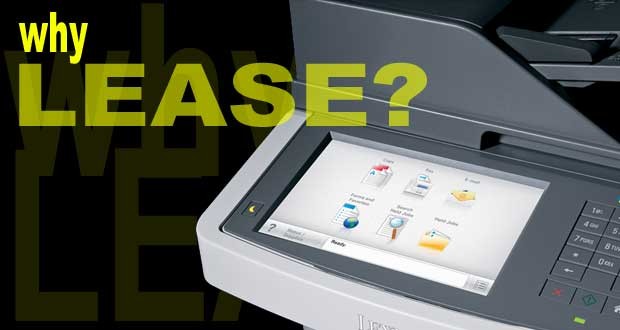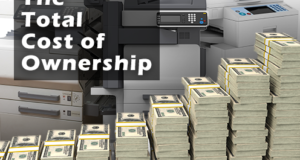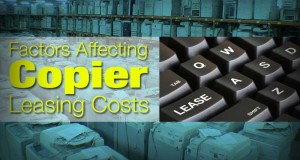There are a million reasons why leasing a copier or MFP might be a good idea. If you’re still on the fence, however, we’ve compiled a few key areas you may want to consider before taking the plunge. These are just the top reasons surrounding the idea of a copier lease and range in scope from financial considerations to productivity concerns. The bottom line is that every office environment offers reasons for and against leasing. While we can’t imagine not leasing a copier or printer, the truth is that you want to take all the major factors into account so that you’re certain you’re making the right call.
Financial Advantages and Disadvantages to Leasing a Copier
First and foremost, leasing a copier allows you to retain your value and critical capital. Leasing a copier allows you to expense your copier or multifunction printer as part of doing business, but it frees up your capital and your credit lines for other investment and expenditure opportunities. A lease offers 100% financing, so you don’t need a lot of cash up front to get your unit(s) into the office. Even with multiple products being leased, your initial expenditure will be low compared to the down-payment (and reduced credit line) of an up-front purchase. Leases are also typically easier to set up and initiate than bank loans, requiring less paperwork and certainly less collateral (the collateral is simply the machine itself).
Another area of savings when leasing a copier is sales tax. While a small MFP or printer may not present much of an issue in this area, replacing or upgrading several large units in a small- to medium-sized business can mean a huge tax bill. And sales tax is due upon the completion of the sale—up front. With a lease, you don’t incur those fees up front, but (typically) defer them over time in most jurisdictions.
There are also advantages to your business’ balance sheet in that an operating lease doesn’t show up as a liability except for the monthly amount. It also doesn’t have to be depreciated as an asset. Instead, a lease is typically a fully-deductible expense that drops your company’s taxable income from profits. It also helps you budget in that you aren’t factoring in large capital expenditures, but rather a monthly lease fee for the equipment you use.
Leasing a Copier to Expand Your Business or Work More Profitably
It’s easy to focus on the expenditure of a leased piece of equipment, but the other side of the coin is that you also have opportunities to work smarter, faster and with greater profitability. If you can get more done, more quickly, your business has a greater potential to take on or accomplish more work. That means more potential for revenues from existing work as well as new opportunities. Another technique we see a lot of people use is staggered leasing whereby they maintain a new piece of equipment almost every year by allowing their leases to expire at different times. That means that you can continue to benefit from advancements in technology every year simply by changing over your oldest equipment to the newest models. The gains in efficiency and productivity here can be immense.
Not My Problem!
We may make fun, but the bottom line is that leasing a copier or MFP, and carrying an accompanying maintenance agreement, truly puts the responsibility for the ongoing maintenance of the product to someone else. You get to continue focusing on productivity, and you don’t have to allocate resources and personnel to keeping your equipment functioning. In most cases, maintenance agreements also mean that the only thing you need to supply is paper (and perhaps staples)—the rest is handled under your per-page/print contract. That’s a lot of peace of mind and often enough to convince most people that leasing office equipment like this is the way to go.
The Downside of Leasing a Copier or Printer
As with any financing situation, leasing costs money. The financial advantages are pretty clear, but you are paying the finance fees for the equipment over time. While you save on initial capital outlay, you’ll typically pay a higher interest rate on a lease versus a capital loan. And, of course, cash will save you the most—just be sure to check out our cautions above regarding large capital outlays.
Comparing a Lease vs a Bank Loan:
| COPIER or PRINTER LEASE | BANK LOAN | |
| Approval time | 2-4 hours with credit check | Days to weeks |
| Financeable amount | 100% | 20-30% (typical) |
| Down payment | Typically a couple of months | Significant down payment plus collateral |
| Financial statements | Minimal requirements, if any, plus credit check | Significant requirements plus annual requests |
| Sales tax | Distributed across life of lease | Included as debt on balance sheet |
| Tax benefits | Typically 100% deductible as business expense | Depreciated over time per IRS requirements |
| Application process | Typically one form | Forms, tax returns, additional documentation |
| Opportunity cost | Leaves credit lines and cash virtually untouched | Cuts into credit lines or drains cash reserves |
 CopierGuide Copier and Multifunction Printer Leases and Reviews
CopierGuide Copier and Multifunction Printer Leases and Reviews





